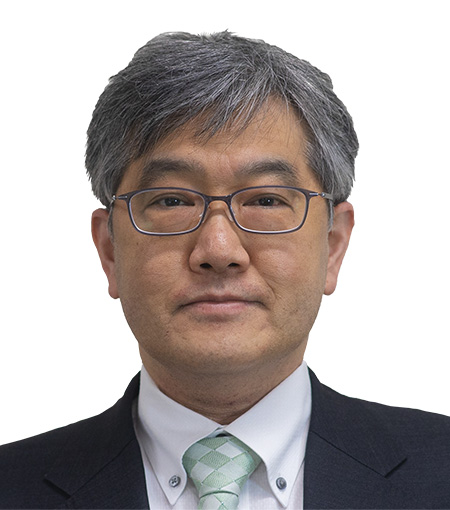- JST Home
- /
- Strategic Basic Research Programs
- /
 CREST
CREST- /
- Research Director/
- Exploring Innovative Materials in Unknown Search Space/
- [Exploring Unknown Materials] Year Started : 2022
[Exploring Unknown Materials] Year Started : 2022
Masaki Azuma
Development of functional perovskite and related compounds utilizing amorphous precursors
Grant No.:JPMJCR22O1
Research Director
Masaki Azuma

Professor
Institute of Integrated Research
Institute of Science Tokyo
Collaborator
| Keigo Kamata | Professor Institute of Integrated Research Institute of Science Tokyo |
| Yu Kumagai | Professor Institute for Materials Research Tohoku University |
| Takumi Nishikubo | Researcher Eco-materials for next-generation semiconductors group Kanagawa Institute of Industrial Science and Technology |
Outline
The need for new materials and substances in the energy and environmental fields is increasing for the construction of a sustainable society. In this research, we target negative thermal expansion materials and selective oxidation catalyst materials, both of which are highly desired in industry, and explore new materials by a new method of combined high-throughput synthesis of multi-element compounds from amorphous precursors and machine learning.
Hitoshi Tabata
Creation of Oxide Materials with Innovative Functions Aided by Environmental Fluctuation
Grant No.:JPMJCR22O2
Research Director
Hitoshi Tabata

Professor
The Graduate School of Engineering
The University of Tokyo
Collaborator
| Tamio Oguchi | Specially Appointed Professor Graduate School of Engineering Science The University of Osaka |
| Iwao Kawayama | Associate Professor Graduate School of Energy Science Kyoto University |
| Munetoshi Seki | Associate Professor Graduate School of Engineering The University of Tokyo |
Outline
We are creating sensor, memory, and computation materials utilizing dipole and spin coupling due to flexoelectricity induced by strain gradient lattice distortion, taking advantage of the versatile physical properties of functional oxides and high crystal structural tolerance due to ionic bonding properties. Aiming to create new functions for oxide materials, we are inspired by biological functionality and actively utilize “thermal fluctuation,” which has usually been considered a “noise,” by using it as an energy source in the environment. We will design and develop innovative low-power-consumption and/or high-sensing materials based on the “stochastic resonance” principle.
Ryuji Tamura
Phason engineering: Materials innovation via modification of atomic tiling
Grant No.:JPMJCR22O3
Research Director
Ryuji Tamura

Professor
Faculty of Advanced Engineering
Tokyo University of Science
Collaborator
| Keiichi Edagawa | Professor Institute of Industrial Science The University of Tokyo |
| Satoshi Kameoka | Professor Institute of Multidisciplinary Research for Advanced Materials Tohoku University |
| Ryo Yoshida | Professor The Institute of Statistical Mathematics Inter-University Research Institute Corporation Research Organization of Information and Systems |
Outline
We propose and establish new materials design concept “Phason engineering”, which enables us to introduce local and global tiling deformation into materials through the phason degree of freedom, in addition to conventional materials design methodology. The target materials are 3D metallic and 2D van der Waals quasicrystals(QCs) and approximants(ACs) which are expected to exhibit superior properties impossible for ordinary crystals. In this project, we elucidate the influence of the local/global modification of atomic tiling on the materials properties, and pursue novel and peculiar magnetic, electronic and catalytic properties in the above QCs and ACs.
Taro Hitosugi
Development of Molecular-Crystal Solid-State Batteries
Grant No.:JPMJCR22O4
Research Director
Taro Hitosugi

Professor
Graduate School of Science
The University of Tokyo
Collaborator
| Yoshitaka Tateyama | Professor Institute of Integrated Research Institute of Science Tokyo |
| Makoto Moriya | Associate Professor Academic Institute Shizuoka University |
Outline
Focusing on molecular crystals, we develop high-performance all-solid-state batteries. We work on the following three projects by combining automated material exploration technologies and theoretical calculations. 1) Development of molecular crystal composites showing high ionic conductivity, 2) Investigating the superionic conductivity mechanism at the molecular crystals and filler interfaces, 3) Demonstrating a self-healing all-solid-state battery, and 3) Demonstrating a self-healing all-solid-state battery.
Teppei Yamada
Creation of phase-transition nanofluids toward high-efficiency thermoelectric conversion
Grant No.:JPMJCR22O5
Research Director
Teppei Yamada

Professor
Graduate School of Science
The University of Tokyo
Collaborator
| Yoichi Murakami | Professor Institute of Integrated Research Institute of Science Tokyo |
| Hirofumi Yoshikawa | Professor School of Engineering Kwansei Gakuin University |
Outline
Dispersions of nanoparticles that can undergo a phase transition upon electrochemical stimulation are referred to here as ”phase-transition nanofluids”. The phase-transition nanofluids have fluidity and the ability to transfer electrons in response to temperature and are expected to become new thermoelectric material. In the project, we build up the basic science of the material and thermoelectrics.













